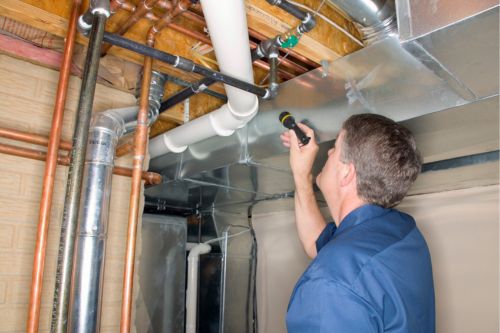Turnkey vs. Fixer-Upper: Pros and Cons

The beauty of real estate is that different properties satisfy different needs. Although single-family homes are great for putting down roots, that may not be your motivation for purchasing your next home. If you’re looking to buy a property with the intent of renting it, both turnkey and fixer-upper listings will cross your path during your home search. The main difference between the two is the condition of the property when you buy it. The right one for you depends on your needs as a homeowner and your goals as a landlord.
What is a turnkey property?
Turnkey properties are move-in ready from day one, which means they’re ready for you to rent them out immediately. Whether it’s a new construction home or a recently remodeled listing, these properties are in tip-top shape when they hit the market. Companies that specialize in renovating and selling these properties may also offer property management services, which may appeal to you if you’re looking for a more hands-off approach to managing your investment property.
What does fixer-upper mean in real estate?
Compared to turnkey listings, fixer-uppers are on the opposite end of the investment property spectrum. Buying a fixer-upper means you’re purchasing a home that needs repairs, remodeling, and some major TLC before it’s ready to rent out. These properties are diamonds in the rough; you’re betting on your ability to make high ROI home upgrades that will attract future renters and put money in your pocket.

Turnkey vs. Fixer-Upper: Pros and Cons
Turnkey Pros
Because they are move-in ready, turnkey listings have the potential to generate cash flow right away. Without any pending renovations in your way, you can open up the property to renters as soon as you take possession. They’re primed and ready to place in the hands of a property management company, which means you’ll get passive income without having to deal with day-to-day operational tasks. You can also ask the listing agent for permission to use their photos, which can help your rental stand out amongst the competition in your area.
Turnkey Cons
So, what’s the catch? These benefits all come at a cost; turnkey properties typically cost more than fixer-uppers. You’ll pay a premium for the pristine condition and the buttoned-up appearance of these properties, so it’s important to have a strategy to save money for your home purchase. Also, handing off property management duties to a third party means you’ll have less control over the renting process. For more information on whether hiring a property management company is right for you, read the following blog post:
Fixer-Upper Pros
Searching for homes in less-than-pristine condition can give you a leg up as a buyer. Fixer-upper homes tend to have less competition from buyers than turnkey properties, since not everyone is willing to take on a major remodeling project. Talk to your agent about how to make the best offer. Given their lessened condition, you can oftentimes get a great deal on these homes with the right strategy. And the best part is, your remodeling efforts will increase the home’s value over time. The more effort you put in, the more the property will be worth, which means higher ROI potential.
Fixer-Upper Cons
Here’s the downside with fixer-uppers: tapping into their potential requires pouring money into the property. Exactly how much you can expect to spend on a fixer-upper varies by location, the size of the home, and the scope of repairs and renovations needed. Tackling some remodeling projects DIY can save you money, but if certain projects require more skilled hands, it may be best to hire a professional. And for all your planning, it’s impossible to predict the future. Projects may go over budget, material costs may rise, and the market may look completely different when you’re ready to rent out your property than it did when you bought it. For more information on buying a fixer-upper and the special financing options available to you, read the following blog post:
Your real estate agent is your greatest asset in helping you determine which property type is right for you. Connect with a local Windermere agent to see which turnkey and fixer-upper properties are available in your area:
May 2023 Market Insights
May 2023 in Stanwood and Camano Island, the current combined inventory is higher than it was at the same time last year, with a total of 105 active residential listings at the end of May 2023 as compared to 88 last May (a 19% year over year increase). Even with this, our markets still have tight inventory remaining firmly in a Sellers’ market with about 1.9 months’ supply of inventory. At the same time, we have seen decreases in new listings added to our markets, with 87 added in May 2023. That is 38% less than added last year at this time.
Buyers are still being selective in their purchases, with changes in lifestyle needs motivating the majority of moves. Our market prices peaked in April/May of 2022. And we saw a steady decline in average prices in the latter part of last year. In 2023, we are seeing a slow but steady recovery growth in sales prices, pending and closed sales.
New Listings: We saw 87 new listings added to our inventory last month, 45 on Camano Island and 42 in Stanwood. This is significantly less than the 120 added at the same time last year.
Pending Sales: Year-over-year Pending sales for May have dropped by 37%, from 89 last May 2022 to 65 last month. But, month to month, we are up over a 20% increase from last month when we saw only 54 listings go pending.
Properties Sold: We had 49 sales closed in our market last month, compared to 74 last year at the same time. We have seen that number consistently increasing month over month during 2023.
Sale Price: Average sales prices of properties sold in Stanwood and Camano Island have increased in the month of May. They are $637,492 in Stanwood and $724, 336 on Camano Island, up over 14% since the beginning of the year.

As inventory increases month to month, so does the competition for your home sale. Take advantage of pent-up buyer demand and a sellers’ market by getting your home on the market now. Remember that all we can control when selling a home is price and condition. It is still important to price your home appropriately and get it market ready so it will shine against its competition.

Based on our month to month increases, buyers waiting for prices to come down will be disappointed based on current trends. The time to buy is now before prices rise further. We have a higher inventory available for buyers to choose from than we have had in over two years. With over 100 homes available in our two combined zip codes, you are more likely to find the perfect home for you.
At Windermere, our responsiveness to the local market, dedication to the community, and commitment to our trade is why we help our clients buy and sell more real estate in Stanwood and Camano Island than any other company.
We are all in, for you.
Jill Vail
REALTOR®
Owner, Designated Broker
Windermere Stanwood & Camano Island
jillvail@windermere.com
360-387-HOME
Jill Vail
REALTOR®
Owner, Designated Broker, Windermere Stanwood & Camano Island
360-387-HOME
.
10 Important People in the Home Buying Process

It takes a village to purchase a home. Though it’s ultimately you who is paying for the property, successfully purchasing a home is a result of several people’s contributions. It helps to know who these individuals are, how they responsibilities pertain to your home purchase, and when you’ll encounter them during your journey. Here are ten important people to keep in mind during the process of buying a home.
10 Important People in the Home Buying Process
1. Real Estate Agent
You’ll be represented by a buyer’s agent throughout the home buying process. Their access to resources and their specialized knowledge will help you find the home you’re looking for and make an offer to the seller. They will be by your side from day one, through closing and beyond. When searching for a real estate agent, ask questions to gain an understanding of their professional expertise as well as their personality. You’ll be working closely together throughout the process, so it’s important to identify someone who is compatible.
2. Mortgage Lender
You need financing to buy a home. Mortgage lenders offer different home loans to match what buyers can afford and what homes they’re looking to purchase. After identifying which lender you’d like to work with, a helpful first step is to get pre-approved for a mortgage by submitting financial information for their review. This helps to speed up the home buying process and solidifies your offer by demonstrating that you’re ready to buy.
3. Mortgage Broker
Your mortgage broker will work with you to find favorable mortgage terms for your home loan. Whereas your real estate agent works with you to find a home and communicates with the seller on your behalf, your mortgage broker works on the financial side of the transaction. Once you’ve chosen the right loan product, they’ll hand things off to the lender.
4. Underwriter
Another key player in the mortgage process is the underwriter. Underwriters review mortgage applications, looking at credit history to assess your ability to pay your loan. A mortgage loan doesn’t get the green light without an underwriter’s approval; if they find any issues, they’ll either deny the loan or require the applicant to provide more information before deciding.
5. Home Inspector
The home inspection is key to the home buying process. It gives you a chance to get a thorough examination of the home to discover which repairs need addressing, if any. The findings of the home inspector’s report will set the table for continued negotiations with the seller and their agent. Buyers will often include a home inspection contingency in their offer to allow for renegotiation or canceling the contract entirely.

Image Source: Getty Images – Image Credit: Jupiter Images
6. Home Appraiser
A professional appraiser will determine a home’s appraised value, which ensures that the lender is loaning the correct amount of money. Home appraisers are third parties to real estate transactions; they have no vested interest in either side of the deal. The home’s square footage, features, and condition all factor into their assessment. If there’s a discrepancy between a home’s appraised value and the loan amount, you and the seller will go back into negotiations.
7. Seller
It takes two to tango. The seller is your counterpart in the home buying process, and they want to sell their home for the best price to the right buyer. Accordingly, you’ll work with your agent on how to make an offer that’s most appealing to the seller. This looks different for each real estate transaction. For example, if you find yourself in a bidding war, the seller may value offers that show flexibility toward the inspection and contingencies. Talk to your agent for more information.
8. Listing Agent
The listing agent represents the seller. Your agent will work with them to iron out the details of your offer and move the deal along toward completion. After the home inspection, the listing agent will also be the main point of contact for any repair requests.
9. Title Company
Before the home is officially yours, a title company will conduct a search of the property’s history and public records to make sure its title is in good legal standing. Titles and deeds have very specific language that makes the transfer of ownership official. Title companies will make sure that everything in these documents is properly recorded during the closing process.
10. Homeowners Insurance Company
Once you’ve purchased a home, you need to protect it. Homeowners insurance policies cover your home, your belongings, injury, or property damage to others, and living expenses if you are temporarily displaced from your home due to an insured disaster. The coverage you’ll need will depend on your home’s location and condition, but what’s most important is that you’re fully protected as a homeowner.
For more information on the home buying process, connect with a local Windermere agent:
Written by Sandy Dodge
To sell your home for the best price, it needs to be in pristine condition. You’ll work with your agent to identify high-ROI remodeling projects and various ways to improve the property, but all that is a moot point if you don’t declutter before selling your home. Here are some helpful tips to get started.
Declutter Before Selling Your Home
Getting your home cleaned up and organized is a precursor to capturing appealing listing photos and having successful open houses. You’ll be opening your doors to crowds of interested buyers, and it’s essential that your home feels like a place they want to live. Decluttering will also get you prepared for home staging, whether you’re hiring a professional or staging your home DIY. All these preparatory measures work together to make your home as appealing as possible to a wide pool of buyers.
Decluttering also helps to kickstart the transition of moving out. Homeowners are attached to their homes, and the selling process can bring a lot of those emotions to the surface. By going through your home room by room, sorting through your possessions and paring them down, you’re simultaneously beginning to process the life changes in your near future. Plus, by getting an early jump on organizing your home, it will make moving day a whole lot easier.
For buyers, space equals opportunity, so a tidy, uncluttered home allows them to fill it with their imagination. As such, it’s crucial that buyers see decluttered, spacious areas when they walk into your home or browse through listing photos online.

Image Source: Getty Images – Image Credit: miodrag ignjatovic
How to Declutter Your Home
Take a deep breath; your decluttering doesn’t have to get done all in one sitting. Tackle your home room by room, taking stock of items as you go. The tried-and-true home organization method of keeping boxes labeled “donate,” “keep,” and “throw away” applies here. Separating items by their destinations will help you reduce piles of clutter in no time.
To properly declutter before selling, consider your moving timeline. Between your discussions with your agent and your preparations for your next home, moving day can go from a seemingly distant point in the future to tomorrow in a hurry. Planning a yard sale can help to give yourself a specific deadline by which you need to have finished giving the house a clean sweep.
Emphasize tidiness in small and narrow areas such as hallways, closets, and storage rooms and consider hanging mirrors to make these areas feel less cramped. These little tricks of the trade can help to give the impression that even the spatially limited areas of your home feel bigger. Scrub, wash, and dust the house top to bottom, even the commonly missed cleaning spots. A home that’s sparkling clean is more welcoming to buyers.
Talk to your agent about additional preparations that will put your home in the best position to sell. Your agent knows what buyers in the area are looking for, so lean on them for advice as you get ready to hit the market. For more information on how to get your home ready to sell, visit our selling guide:
Written By Sandy Dodge
Jill Vail
REALTOR®
Owner, Designated Broker, Windermere Stanwood & Camano Island
360-387-HOME
.
You’ve seen “For Sale” signs around your neighborhood, but what does it take to actually put your home on the market? First-time home sellers often enter the selling process unaware of what’s to come, their heads full of questions. Understanding the selling process will inform your conversations with your real estate agent and will help you stay organized and on schedule as you sell your home for the first time.
8 Tips for First-Time Home Sellers
1. Know the Costs of Selling a Home
Though you’ll eventually walk away from the sale of your home with a lump sum in your pocket, the selling process isn’t without its costs. Real estate agent commission costs typically account for five to six percent of the sale price, but they’re not the only expense you’ll encounter on your selling journey. Between repairs, home upgrades, staging, escrow fees, Capital Gains Tax and more, it’s important to budget for these costs before listing your home.
2. Find the Right Agent
A successful selling experience starts by working with a professional real estate agent. Real estate agents specialize in keeping up with local market conditions, they have the tools to competitively price your home, and they understand what is driving buyer interest in your area. But beyond these qualities, it’s important that first-time home sellers choose an agent who understands their goals and cares about their happiness. Selling a home can be an emotional roller coaster and having a trusted expert beside you will help you navigate its ups and downs.
3. The Importance of Home Staging
Whether you hire a professional or decide to stage your home yourself, what’s important is that you make the commitment. Staging your home creates universal appeal, capturing the attention of the widest possible buyer pool. If your interior is too personalized, it makes it harder for buyers to see themselves in your home. Staging makes financial sense as well, as it often equates to higher sales prices. According to a 2020 survey performed by the Real Estate Staging Association (RESA®), of the 13,000 homes surveyed, 85% of staged homes sold for 5-23% over list price.1
4. High ROI Remodeling Projects
Remodeling projects cost a significant amount of money; there’s no way around it. This is where your agent’s expertise can help you spend wisely: they can inform you of which home features and upgrades are driving buyer interest in your area. Target the high ROI remodeling projects that increase home value to get the most bang for your buck and know which remodeling projects to avoid when selling your home.

Image Source: Getty Images – Image Credit: Hispanolistic
5. Pre-Listing Inspection
Anything that could potentially give your home a competitive advantage over other listings is worth discussing with your agent. One such strategy is conducting a pre-listing inspection before putting your home on the market. Not only do pre-listing inspections give sellers a better understanding of what repairs may be in order, but they also streamline the selling process by transparently disclosing the details of a property’s condition to the buyer. These reports are especially helpful in competitive markets, since buyers are more likely to waive inspections.
6. How to Price Your Home
Of all the information coming at you during the selling process, you’ll likely have your mind set on getting the best price for your home. Determining home value is one area where real estate agents excel; their Comparative Market Analysis (CMA) will help them set an accurate and competitive figure. It’s important to separate your emotional attachment to your home from your agent’s calculations. In your mind, your home possesses a certain value, but that may not match what it can realistically fetch on the market. Sometimes it may be even more than you thought!
7. Safety Tips for Open Houses
The more buyer interest you’re able to drum up, the better. Open houses play an important role in the selling process in that they allow buyers to experience the property firsthand. Making this connection requires opening your doors to strangers, which is cause for taking the appropriate safety measures. Remove all prescriptions from your medicine cabinets, lock up precious belongings and personal information, make sure all doors and windows are locked at the end of each day, and discuss your buyer screening process with your agent so you’re on the same page.
8. Moving Timeline
The planning doesn’t stop once you’ve sold your home. Before the ink is dry on your real estate contract, your gears will be turning about how to efficiently move into your new home. We’ve created an interactive Moving Checklist with a step-by-step guide to the moving process, from twelve weeks before moving day all the way up until you make your move. The list is also available as an interactive web page and downloadable PDF here:
For more information on the selling process from list to closing, visit our comprehensive selling guide here:
Written by Sandy Dodge
1: Real Estate Staging Association (RESA®). “The Consumer’s Guide to Real Estate Staging.” Realestatestagingassociation.com. 2020.
Your local market conditions dictate the real estate climate around you. Where things are on the buyer’s/seller’s market spectrum will impact how you and your Windermere real estate agent approach selling your home. As a part of this process, it’s important to understand the different types of markets and how their conditions play into accurately pricing your home.
See the latest data on home sales, home prices, mortgage rates and more for your area here:
What is a seller’s market?
The housing market is categorized as a seller’s market when demand for homes is greater than the supply on the market. With limited inventory, competition is high amongst buyers. This drives home prices up, decreases days on market, and often leads to multiple offers from buyers. These are ideal conditions for selling your home, given that buyers are forced to continually sweeten their offers to win out. For example, buyers are often more apt to remove contingencies from their offers in a seller’s market.
What is a buyer’s market?
A buyer’s market is on the opposite end of the real estate market spectrum. It is usually defined as having six or more months of available inventory—meaning if no new homes were listed, it would take six (or more) months for all available listings to sell.
Because there’s greater supply than demand, there’s less competition among buyers, and it’s the buyer’s agents who often have the leverage during negotiations. Selling in these conditions emphasizes the importance of investing in improving your home before putting it on the market.
Selling Your Home in a Balanced Market
A balanced market exists in equilibrium between a seller’s market and a buyer’s market. It is the middle part of the Venn diagram between the two; it shares certain aspects of each, but only dips its toes into both.
When your local real estate market is balanced, it’s important to approach the selling process with a realistic mindset. In a balanced market, bidding wars are less likely and the chances of buyers having complete leverage are slim. These conditions, however, are all the more reason to make your home stand out amongst competing listings. Making repairs, remodeling, and boosting curb appeal can all help attract buyers while increasing the value of your home.
When coming out of a seller’s market, it’s important not to panic when your local real estate market experiences a cool-down or a return toward balance. In a balanced market, there are still plenty of buyers actively seeking homes, albeit at a lesser pace. Even as aggregate home sales decline and days on market increase, these market conditions should not be confused with more extreme situations like the housing market crash of the late 2000s.
Our Chief Economist Matthew Gardner covers recent housing marketing conditions as they compare to the Great Recession. Read his analysis in two recent articles:
Working With an Agent to Sell Your Home
All these factors highlight the importance of working with your agent to accurately price your home in a balanced market. Real estate agents have access to the Multiple Listing Service (MLS), which gives them access to a huge network of data on available homes both present and historical. They’ll use this data to conduct a Comparative Market Analysis (CMA) to competitively price your home. To get started, connect with a local, experienced Windermere agent:
February 2023 in Stanwood and Camano Island showed upticks in new listings and pending sales compared to January. Based on the activity, it appears that a degree of balance is returning to the market.
New Listings: There were 66 new listings added to inventory last month, 38 in Stanwood and 28 on Camano Island. This is only 1% fewer than 12 months ago.
Pending Sales: Volume of pending sales increased 14%, from the year-ago total of 51 to 59.
Homes Sold: Year over year closed sales declined 22% from 47 to 37 transactions.
Sale Price: Average sale prices in Stanwood and Camano Island slipped 10% and 17% respectively from last February.
SELLERS – There will most likely be a shortage of inventory this spring, but the Buyers are out there! Multiple offers are being seen on the right properties despite the interest rates. Price is important. If you are thinking of listing your home, meet with your local agent to discuss market value and additional value they can bring.
BUYERS – Get pre-approved for a mortgage now. This will give you a better idea of your budget and price range to focus on. Be patient! The current market is still a bit competitive, so it may take some time to find the right home at the right price. Hire a local agent who knows this area and market well.
At Windermere, our responsiveness to the local market, dedication to the community, and commitment to our trade is why we help our clients buy and sell more real estate in Stanwood and Camano Island than any other company.
We are all in, for you.
.


Marla Heagle
REALTOR®
Managing Broker, Windermere Stanwood & Camano Island
360-387-HOME
.
Throughout the home buying process, you’ll encounter several checkpoints. At every stop, you’ll get closer to the ultimate goal of purchasing your next home. Each one satisfies unique criteria required to become a homeowner, and each one has its own terminology. Before you begin your home buying journey, it’s helpful to know about pre-approval, pre-qualification, and proof of funds, and the role they play in a real estate transaction.
Pre-Qualification and Pre-Approval
What is pre-qualification?
Pre-qualification and pre-approval go hand in hand, but one precedes the other. Pre-qualification is a very early step in the home buying process leading to pre-approval. After sharing your financial information with your bank or lender, they’ll give you an estimate of the loan amount you can expect to qualify for. During this time, you’ll learn about the different home loans available to you to help you decide which is best. Pre-qualification usually only takes a few business days.
What is pre-approval?
A sibling to pre-qualification, pre-approval takes things a step further. Once you submit a mortgage application, you’ll provide your lender with the required information to perform a financial background check to assess your creditworthiness. You’ll get a pre-approval letter showing the lender’s offer of a specific loan amount, so you’ll know how much you can borrow. You’ll also get a better understanding of what interest rate you can expect to pay on your loan. Mortgage pre-approvals are typically valid for 60 to 90 days.
More information on the benefits of pre-approval and when to get pre-approved:
Once you’ve gone through the pre-approval process, it’s helpful to know which homes you can afford. Use our free Home Monthly Payment Calculator by clicking the button below. With current rates based on national averages and customizable mortgage terms, you can experiment with different values to get an estimate of your monthly payment for any listing price.

Image Source: Getty Images – Image Credit: Thitiphat Khuankaew
What is a proof of funds letter?
Simply put, in real estate, a proof of funds letter is a document that proves to the seller that you have enough money available to purchase the home. Proof of funds letters may vary depending on the terms of the transaction. For example, if you’re making an all-cash offer, your letter will prove that you have enough liquid cash to complete the deal.
For more information on the home buying process, read our blog post on searching for a home:











